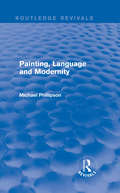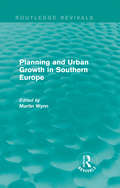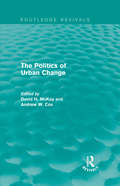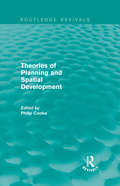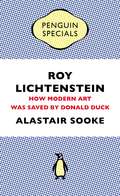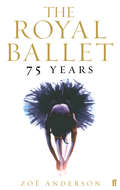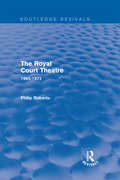- Table View
- List View
Routledge Revivals: Painting, Language and Modernity (1985)
by Michael PhillipsonFirst published in 1985, this book draws together the author’s artistic with analytical practices which had been developed over many years of sociological enquiry. It interprets a ‘work of art’ as a site on which a viewer or critic is invited to share in questioning celebration of the painting itself. The author reassesses modern painting’s relation to its own origins and to tradition in light of the emergence of ‘postmodern’ practice — exploring its engagement of fundamental questions about language and being. Also assessed is the relevance of the metaphors of writings and Reading to an understanding of painting and viewing practices — looking at painters’ writings as well as phenomenological and post-structuralist writers.
Routledge Revivals: Planning and Urban Growth in Southern Europe (Routledge Revivals)
by Martin WynnFirst published in 1984, this book addresses key questions about the pattern of urban development in Southern Europe and the mechanisms employed to control and regulate this development in individual countries. It examines five countries – Greece, Italy, Portugal, Spain and Turkey – that have experienced different scales and rates of urbanization and industrialization. It identifies common problems arising from these processes, as well as the successes and failures of the planning policies employed to regulate development. This book will be of great value to geographers interested in Southern Europe and urban and regional planners interested in comparative patterns of development.
Routledge Revivals: Planning and Urban Growth in Southern Europe (Routledge Revivals)
by Martin WynnFirst published in 1984, this book addresses key questions about the pattern of urban development in Southern Europe and the mechanisms employed to control and regulate this development in individual countries. It examines five countries – Greece, Italy, Portugal, Spain and Turkey – that have experienced different scales and rates of urbanization and industrialization. It identifies common problems arising from these processes, as well as the successes and failures of the planning policies employed to regulate development. This book will be of great value to geographers interested in Southern Europe and urban and regional planners interested in comparative patterns of development.
Routledge Revivals: The Politics of Urban Change (1979)
by David McKay Andrew CoxFirst published in 1979, this book examines key planning policy areas such as land use planning, land values, housing and slum clearance, urban transport, industrial and regional economic location policies, and policies inner city policies to explain why particular policies have been adopted at particular times — assessing the role of political parties, bureaucrats and interests in setting the national policy agenda. Policy is also placed in the broader economic and social context and the question of whether, given contemporaneous constraints, a coherent national urban policy is possible is examined. Its focus on political parties’ role in urban change at the start of Thatcher-era upheavals makes this book especially valuable to students of urban sociology and the history of planning.
Routledge Revivals: The Politics of Urban Change (1979)
by David H. McKay Andrew W. CoxFirst published in 1979, this book examines key planning policy areas such as land use planning, land values, housing and slum clearance, urban transport, industrial and regional economic location policies, and policies inner city policies to explain why particular policies have been adopted at particular times — assessing the role of political parties, bureaucrats and interests in setting the national policy agenda. Policy is also placed in the broader economic and social context and the question of whether, given contemporaneous constraints, a coherent national urban policy is possible is examined. Its focus on political parties’ role in urban change at the start of Thatcher-era upheavals makes this book especially valuable to students of urban sociology and the history of planning.
Routledge Revivals: School Design (Routledge Revivals)
by Henry SanoffEducators often overlook the positive impact of changing the environment of the school itself when considering how to improve the quality of education. First published in 1994, School Design shows how to create more effective schools through a design process that involves teachers, students, parents, administrators, and architects. It reveals how to create school environments that develop the whole child, instil enthusiasm for learning, and encourage positive social relationships. Readers discover how to integrate design research, design participation, and design development to optimize school settings. Using a number of case studies, detailed practical methods show how to: Link behavioural objectives to spatial needs Achieve spatial efficacy without compromising education Match children’s developmental needs to facility requirements Promote greater variety in physical facilities to accommodate various teaching and learning styles Gain more valuable feedback from teachers, parents, students, and local citizens on building performance. In response to tight school budgets, Henry Sanoff discusses how relatively minor design modifications can have a major positive effect on school performance. This path-breaking volume will provide architects, teachers, and school administrators with a wide array of insights into creating spaces that promote better learning.
Routledge Revivals: School Design (Routledge Revivals)
by Henry SanoffEducators often overlook the positive impact of changing the environment of the school itself when considering how to improve the quality of education. First published in 1994, School Design shows how to create more effective schools through a design process that involves teachers, students, parents, administrators, and architects. It reveals how to create school environments that develop the whole child, instil enthusiasm for learning, and encourage positive social relationships. Readers discover how to integrate design research, design participation, and design development to optimize school settings. Using a number of case studies, detailed practical methods show how to: Link behavioural objectives to spatial needs Achieve spatial efficacy without compromising education Match children’s developmental needs to facility requirements Promote greater variety in physical facilities to accommodate various teaching and learning styles Gain more valuable feedback from teachers, parents, students, and local citizens on building performance. In response to tight school budgets, Henry Sanoff discusses how relatively minor design modifications can have a major positive effect on school performance. This path-breaking volume will provide architects, teachers, and school administrators with a wide array of insights into creating spaces that promote better learning.
Routledge Revivals: Theories of Planning and Spatial Development (Routledge Revivals)
by Philip CookeFirst published in 1983, this book attempts to unify two bodies of theory which had become severely disjointed. Theories of the planning process had become detached from those of the urban and regional processes which are the subject of planning intervention. The author argues that major weaknesses of planning intervention in cities and regions have resulted from this split, and shows how it is possible to develop an integrated theory of the relationship between planning and spatial development. The mechanism which helps to unify the two fields is the division of labour. This poses problems for the planning system as its spatial requirements change but it depends upon the state planning framework in order to overcome those obstacles — hindering its capacity for spatial reorganisation. This book offers a thorough analysis of these obstacles and requirements by references to contemporaneous theoretical advances in the study of the development process, the state (especially at sub-national level), and the labour market. It is argued that the way capital makes use of urban and regional space can be explained by using the theoretical framework which is developed and, on this basis, point to certain innovative ways in which the processes underlying urban and regional de-industrialisation may be countered.
Routledge Revivals: Theories of Planning and Spatial Development (Routledge Revivals)
by Philip CookeFirst published in 1983, this book attempts to unify two bodies of theory which had become severely disjointed. Theories of the planning process had become detached from those of the urban and regional processes which are the subject of planning intervention. The author argues that major weaknesses of planning intervention in cities and regions have resulted from this split, and shows how it is possible to develop an integrated theory of the relationship between planning and spatial development. The mechanism which helps to unify the two fields is the division of labour. This poses problems for the planning system as its spatial requirements change but it depends upon the state planning framework in order to overcome those obstacles — hindering its capacity for spatial reorganisation. This book offers a thorough analysis of these obstacles and requirements by references to contemporaneous theoretical advances in the study of the development process, the state (especially at sub-national level), and the labour market. It is argued that the way capital makes use of urban and regional space can be explained by using the theoretical framework which is developed and, on this basis, point to certain innovative ways in which the processes underlying urban and regional de-industrialisation may be countered.
Roy Hart (Routledge Performance Practitioners)
by Kevin Crawford Bernadette SweeneyRoy Hart’s revolutionary work on the human voice through extended vocal technique and the Wolfsohn-Hart tradition has influenced several generations of practitioners. Hart’s outstanding contribution to vocal research, practice and performance stretched over 20 years until his untimely death in 1975, and his vocal training produced performers with extraordinary and highly expressive vocal ranges. He founded a theatre company, Roy Hart Theatre, that brought his ideas to realisation in ground-breaking works. His influence, through his own use of the voice for theatre and music and its embodiment in his company, was widespread, attracting the interest of directors such as Peter Brook, Jerzy Grotowski and Jean-Louis Barrault. This book combines: a detailed biography giving the social and artistic context of Hart’s work and that of the early Roy Hart Theatre an exploration of Hart’s own writings on his work, combined with a review of articles by his wife Dorothy Hart and in-depth interviews a stylistic analysis of his key works, including The Bacchae, and, L'Economiste and Biodrame, and their critical reception pathways into some of the practical exercises devised by close collaborators of Roy Hart and practitioners of the Roy Hart Theatre Tradition. As a first step towards critical understanding, and as an initial exploration before going on to further, primary research, Routledge Performance Practitioners offer unbeatable value for today’s student.
Roy Hart (Routledge Performance Practitioners)
by Kevin Crawford Bernadette SweeneyRoy Hart’s revolutionary work on the human voice through extended vocal technique and the Wolfsohn-Hart tradition has influenced several generations of practitioners. Hart’s outstanding contribution to vocal research, practice and performance stretched over 20 years until his untimely death in 1975, and his vocal training produced performers with extraordinary and highly expressive vocal ranges. He founded a theatre company, Roy Hart Theatre, that brought his ideas to realisation in ground-breaking works. His influence, through his own use of the voice for theatre and music and its embodiment in his company, was widespread, attracting the interest of directors such as Peter Brook, Jerzy Grotowski and Jean-Louis Barrault. This book combines: a detailed biography giving the social and artistic context of Hart’s work and that of the early Roy Hart Theatre an exploration of Hart’s own writings on his work, combined with a review of articles by his wife Dorothy Hart and in-depth interviews a stylistic analysis of his key works, including The Bacchae, and, L'Economiste and Biodrame, and their critical reception pathways into some of the practical exercises devised by close collaborators of Roy Hart and practitioners of the Roy Hart Theatre Tradition. As a first step towards critical understanding, and as an initial exploration before going on to further, primary research, Routledge Performance Practitioners offer unbeatable value for today’s student.
Roy Lichtenstein: How Modern Art Was Saved by Donald Duck (Penguin Specials)
by Alastair SookeA Penguin Special on Roy Lichtenstein by Alastair Sooke - read in 2 hours or less'Why, Brad darling, this painting is a masterpiece! My, soon you'll have all of New York clamoring for your work!' Roy Lichtenstein - architect of Pop art, connoisseur of the comic strip, master of irony and prophet of popular culture. From exhilarating images of ice-cool jet pilots in dog fights, to blue-haired Barbie dolls drowning in scenes of domestic heartache, Lichtenstein's instantly recognisable paintings, with their Ben-Day dots and witty one-liners, defined the art of a generation. But how did a jobbing, unassuming painter of the Fifties become a world-famous Pop artist whose work today sells for millions? What do his paintings really tell us? And what is his legacy?This book, by art critic and broadcaster Alastair Sooke, is a perfect introduction to the artist and his work. Spanning Lichtenstein's career, and explaining his unique style, it is a journey through the life of one of the twentieth century's greatest artists.Published in time for a major new retrospective of the work of Roy Lichtenstein.'Sooke is an immensely engaging character. He has none of the weighty self-regard that often afflicts art experts and critics; rather he approaches his subjects with a questioning, open, exploratory attitude' Sarah Vine, The Times'His shows are excellent - clever, lively, scholarly, but not too lecturey; he's very good at linking his painters with the world outside the studio, and at how these artists have affected the world today' Sam Wollaston reviewing 'Modern Masters', GuardianAlastair Sooke is deputy art critic of the Daily Telegraph. He has written and presented documentaries on television and radio for the BBC, including Modern Masters, an acclaimed BBC One series that chronicled modern art in the twentieth century. Since 2009 he has reported regularly for The Culture Show on BBC Two. He was educated at Christ Church, Oxford, and at the Courtauld Institute of Art, London.
Roy Smiles: Ten Plays (Oberon Modern Playwrights)
by Roy SmilesTen plays by comedic playwright Roy Smiles, available as an anthology or as single editions.Contains the plays Schmucks, Baghdad Boogie, Bombing People, Reno, The Lad Himself, Working for Mammon, Waugh in Winter, Reading Gaol, The VIP, and The Weight of Days.
Roy Williams Plays 5: Kingston 14; The Firm; Advice for the Young at Heart; Death of England; Death of England: Delroy (Contemporary Dramatists)
by Roy WilliamsIn his fifth collection of Plays, the work ranges from a spirited, raging drama that investigates police corruption in Jamaica through to two thrilling monologue plays written either side of the Covid-19 pandemic, first presented at London's National Theatre. The political and the personal are drawn together effectively throughout, offering a rich selection of work that showcase Williams's unique talent.Roy Williams has been described as 'one of Britain's most important playwrights' (WhatsOnStage). His career to date has seen him win the Alfred Fagon Award, the George Devine Award, the Evening Standard Award for Most Promising Playwright, a BAFTA Award and nominations for the Olivier Award for Best Play. He was appointed Officer of the Order of the British Empire in 2008 and was made a fellow of the Royal Society of Literature in 2018. Advice for the Young at Heart (2013) "A robust and poignant piece of theatre." - A Younger TheatreKingston 14 (2014) "Should be lauded in staging a culture not exactly over-represented in British theatre ... convincingly suggests such tensions underpin both the island's chaotic political situation, and the wariness between the Jamaican police and the visiting Brit." - IndependentThe Firm (2018) "Williams reveals himself once more as one of the most compelling chroniclers of the complexities of masculinity in a rapidly changing world." - Arts DeskDeath of England (2020) "The most exhilarating and hair-raising drama...This is truly a play for today." - The GuardianDeath of England: Delroy (2021) " A blistering solo show sure to survive England's second lockdown" - Variety
Roy Williams Plays 5: Kingston 14; The Firm; Advice for the Young at Heart; Death of England; Death of England: Delroy (Contemporary Dramatists)
by Roy WilliamsIn his fifth collection of Plays, the work ranges from a spirited, raging drama that investigates police corruption in Jamaica through to two thrilling monologue plays written either side of the Covid-19 pandemic, first presented at London's National Theatre. The political and the personal are drawn together effectively throughout, offering a rich selection of work that showcase Williams's unique talent.Roy Williams has been described as 'one of Britain's most important playwrights' (WhatsOnStage). His career to date has seen him win the Alfred Fagon Award, the George Devine Award, the Evening Standard Award for Most Promising Playwright, a BAFTA Award and nominations for the Olivier Award for Best Play. He was appointed Officer of the Order of the British Empire in 2008 and was made a fellow of the Royal Society of Literature in 2018. Advice for the Young at Heart (2013) "A robust and poignant piece of theatre." - A Younger TheatreKingston 14 (2014) "Should be lauded in staging a culture not exactly over-represented in British theatre ... convincingly suggests such tensions underpin both the island's chaotic political situation, and the wariness between the Jamaican police and the visiting Brit." - IndependentThe Firm (2018) "Williams reveals himself once more as one of the most compelling chroniclers of the complexities of masculinity in a rapidly changing world." - Arts DeskDeath of England (2020) "The most exhilarating and hair-raising drama...This is truly a play for today." - The GuardianDeath of England: Delroy (2021) " A blistering solo show sure to survive England's second lockdown" - Variety
Royal Albert Hall (large print)
by RnibThis page shows two images of the Royal Albert Hall. There is a front view at the top and a plan view at the bottom of the page. There is a locator dot shown, which will be at the top left when the image is the correct way up. In the top centre of the top image is a large glass domed roof. Down from this is red brick with some decorative terracotta features. The building then widens with another red brick wall. This section has four small windows and is topped by terracotta decorations including a frieze which goes right around the building. It shows a series of human figures doing different things and depicts the 'triumph of the arts and sciences'. This detail is not shown. The next section of red brick wall has a line of arched windows framed in terracotta. To the left, centre and right are large portico entrances. The central one is shown from the front. The one to the left and right are shown from the side. This is because the building has an oval shape. The plan view at the bottom of the page helps explain this. Also due to the round shape of the building the windows nearer the left and right edge of the building appear to be narrower. They are in fact all the same width but those to the left and right are shown more from the side and so appear narrow. The plan view at the bottom of the page also helps to explain this. The central entrance at this level has a large rectangular window with a narrow window to the left and right. They are framed in terracotta. There are terracotta decorations above, and to the left and right of the windows. Down from these windows is a large arch which forms one of the four entrances. The arch is lined with terracotta and has terracotta decorations to the left and right. To the left of the arch is a line of tall rectangular windows which are also framed in terracotta. Like the arched windows they appear narrower for the same reason. On the left of the image is the arched entrance to the side of the side entrance. Like the central entrance the arch is lined with terracotta and has terracotta decorations to the left and right. Up from the side arch is a single arched window framed in terracotta. At the bottom of the image between the side and central entrances there are seven windows of different sizes. The building is symmetrical so the features to the left of the central part of the building are repeated in a mirrored pattern on the right. To the left of the central entrance is a family car shown at scale to demonstrate how large the building is. The plan view in the bottom half of the image shows the inside of the hall from above. The external entrances can be found at the top, bottom, left and right, sticking out from the oval shaped hall. The arena in the middle of the image is flat and without permanent seating. It is the lowest part of the hall. The seating around the bottom and sides of the image gets higher towards the external wall. This means there is room for offices near the wall underneath the upper seating.
Royal Albert Hall (UEB contracted)
by RnibThis page shows two images of the Royal Albert Hall. There is a front view at the top and a plan view at the bottom of the page. There is a locator dot shown, which will be at the top left when the image is the correct way up. In the top centre of the top image is a large glass domed roof. Down from this is red brick with some decorative terracotta features. The building then widens with another red brick wall. This section has four small windows and is topped by terracotta decorations including a frieze which goes right around the building. It shows a series of human figures doing different things and depicts the 'triumph of the arts and sciences'. This detail is not shown. The next section of red brick wall has a line of arched windows framed in terracotta. To the left, centre and right are large portico entrances. The central one is shown from the front. The one to the left and right are shown from the side. This is because the building has an oval shape. The plan view at the bottom of the page helps explain this. Also due to the round shape of the building the windows nearer the left and right edge of the building appear to be narrower. They are in fact all the same width but those to the left and right are shown more from the side and so appear narrow. The plan view at the bottom of the page also helps to explain this. The central entrance at this level has a large rectangular window with a narrow window to the left and right. They are framed in terracotta. There are terracotta decorations above, and to the left and right of the windows. Down from these windows is a large arch which forms one of the four entrances. The arch is lined with terracotta and has terracotta decorations to the left and right. To the left of the arch is a line of tall rectangular windows which are also framed in terracotta. Like the arched windows they appear narrower for the same reason. On the left of the image is the arched entrance to the side of the side entrance. Like the central entrance the arch is lined with terracotta and has terracotta decorations to the left and right. Up from the side arch is a single arched window framed in terracotta. At the bottom of the image between the side and central entrances there are seven windows of different sizes. The building is symmetrical so the features to the left of the central part of the building are repeated in a mirrored pattern on the right. To the left of the central entrance is a family car shown at scale to demonstrate how large the building is. The plan view in the bottom half of the image shows the inside of the hall from above. The external entrances can be found at the top, bottom, left and right, sticking out from the oval shaped hall. The arena in the middle of the image is flat and without permanent seating. It is the lowest part of the hall. The seating around the bottom and sides of the image gets higher towards the external wall. This means there is room for offices near the wall underneath the upper seating.
Royal Albert Hall (UEB uncontracted)
by RnibThis page shows two images of the Royal Albert Hall. There is a front view at the top and a plan view at the bottom of the page. There is a locator dot shown, which will be at the top left when the image is the correct way up. In the top centre of the top image is a large glass domed roof. Down from this is red brick with some decorative terracotta features. The building then widens with another red brick wall. This section has four small windows and is topped by terracotta decorations including a frieze which goes right around the building. It shows a series of human figures doing different things and depicts the 'triumph of the arts and sciences'. This detail is not shown. The next section of red brick wall has a line of arched windows framed in terracotta. To the left, centre and right are large portico entrances. The central one is shown from the front. The one to the left and right are shown from the side. This is because the building has an oval shape. The plan view at the bottom of the page helps explain this. Also due to the round shape of the building the windows nearer the left and right edge of the building appear to be narrower. They are in fact all the same width but those to the left and right are shown more from the side and so appear narrow. The plan view at the bottom of the page also helps to explain this. The central entrance at this level has a large rectangular window with a narrow window to the left and right. They are framed in terracotta. There are terracotta decorations above, and to the left and right of the windows. Down from these windows is a large arch which forms one of the four entrances. The arch is lined with terracotta and has terracotta decorations to the left and right. To the left of the arch is a line of tall rectangular windows which are also framed in terracotta. Like the arched windows they appear narrower for the same reason. On the left of the image is the arched entrance to the side of the side entrance. Like the central entrance the arch is lined with terracotta and has terracotta decorations to the left and right. Up from the side arch is a single arched window framed in terracotta. At the bottom of the image between the side and central entrances there are seven windows of different sizes. The building is symmetrical so the features to the left of the central part of the building are repeated in a mirrored pattern on the right. To the left of the central entrance is a family car shown at scale to demonstrate how large the building is. The plan view in the bottom half of the image shows the inside of the hall from above. The external entrances can be found at the top, bottom, left and right, sticking out from the oval shaped hall. The arena in the middle of the image is flat and without permanent seating. It is the lowest part of the hall. The seating around the bottom and sides of the image gets higher towards the external wall. This means there is room for offices near the wall underneath the upper seating.
The Royal Ballet: 75 Years
by Zoë AndersonThis book is a perceptive and critical account of the first 75 years of The Royal Ballet, tracing the company's growth, and its great cultural importance - an indispensable book for all lovers of ballet.In 1931, Ninette de Valois started a ballet company with just six dancers. Within twenty years, The Royal Ballet - as it became - was established as one of the world's great companies. It has produced celebrated dancers, from Margot Fonteyn to Darcey Bussell, and one of the richest repertoires in ballet.The company danced through the Blitz, won an international reputation in a single New York performance and added to the glamour of London's Swinging Sixties. It has established a distinctive English school of ballet, a pure classical style that could do justice to the 19th-century repertory and to new British classics.Leading dance critic, Zoë Anderson, vividly portrays the extraordinary personalities who created the company and the dancers who made such an impact on their audiences. She looks at the bad times as well as the good, examining the controversial directorships of Norman Morrice and Ross Stretton and the criticism fired at the company as the Royal Opera House closed for redevelopment.
Royal Chelsea Hospital (large print)
by RnibThis page shows the Chealsea hospital frontage and a simple plan view of the building. There is a locator dot shown on each page, which will be at the top left when the image is the correct way up. The image of the frontage is in the top and the plan at the bottom of the page. In the top centre of the page a short spike stands up. Down from this is a decorative ball on top of a small onion dome roof. The roof sits on a small tower with two windows. The tower is above the central main grand entrance which is a large portico. This has a roof with a gable end which is supported by four columns. There is a large window above the large door. The building is symmetrical so the structure to the right of the entrance is a reflection of the left side. At ground level there is a covered walkway. The roof of this is supported by six pairs of pillars. The tower, portico, covered walkways and columns are all made from white stone. Up from the walkways are seven large domed windows. The windows are framed by bright red bricks. Up from each window is a decorative recessed rectangle also framed with red bricks. The rest of the wall is brown brickwork. To the left and right of the central facade is the end of the rest of the building. There are three floors each with five windows and three dormer windows set in the roof. On top of the roof are two tall chimneys. The wall is made with brown bricks with decorative white stone edging on the corners. This part of the building is the end of a long wing and is much nearer to you than the central facade. The plan view helps explain this. In the plan view (not to scale with the image at the top of the page) the horizontal section in the top of the image represents the building with the central facade. The sections to the left and right are the wings going down the page. The ends of the building, where the dots are, are the only parts of the wings that can be found in the image at the top of the page.
Royal Chelsea Hospital (UEB uncontcrated)
by RnibThis page shows the Chealsea hospital frontage and a simple plan view of the building. There is a locator dot shown on each page, which will be at the top left when the image is the correct way up. The image of the frontage is in the top and the plan at the bottom of the page. In the top centre of the page a short spike stands up. Down from this is a decorative ball on top of a small onion dome roof. The roof sits on a small tower with two windows. The tower is above the central main grand entrance which is a large portico. This has a roof with a gable end which is supported by four columns. There is a large window above the large door. The building is symmetrical so the structure to the right of the entrance is a reflection of the left side. At ground level there is a covered walkway. The roof of this is supported by six pairs of pillars. The tower, portico, covered walkways and columns are all made from white stone. Up from the walkways are seven large domed windows. The windows are framed by bright red bricks. Up from each window is a decorative recessed rectangle also framed with red bricks. The rest of the wall is brown brickwork. To the left and right of the central facade is the end of the rest of the building. There are three floors each with five windows and three dormer windows set in the roof. On top of the roof are two tall chimneys. The wall is made with brown bricks with decorative white stone edging on the corners. This part of the building is the end of a long wing and is much nearer to you than the central facade. The plan view helps explain this. In the plan view (not to scale with the image at the top of the page) the horizontal section in the top of the image represents the building with the central facade. The sections to the left and right are the wings going down the page. The ends of the building, where the dots are, are the only parts of the wings that can be found in the image at the top of the page.
Royal Chelsea Hospital (UEB uncontracted)
by RnibThis page shows the Chealsea hospital frontage and a simple plan view of the building. There is a locator dot shown on each page, which will be at the top left when the image is the correct way up. The image of the frontage is in the top and the plan at the bottom of the page. In the top centre of the page a short spike stands up. Down from this is a decorative ball on top of a small onion dome roof. The roof sits on a small tower with two windows. The tower is above the central main grand entrance which is a large portico. This has a roof with a gable end which is supported by four columns. There is a large window above the large door. The building is symmetrical so the structure to the right of the entrance is a reflection of the left side. At ground level there is a covered walkway. The roof of this is supported by six pairs of pillars. The tower, portico, covered walkways and columns are all made from white stone. Up from the walkways are seven large domed windows. The windows are framed by bright red bricks. Up from each window is a decorative recessed rectangle also framed with red bricks. The rest of the wall is brown brickwork. To the left and right of the central facade is the end of the rest of the building. There are three floors each with five windows and three dormer windows set in the roof. On top of the roof are two tall chimneys. The wall is made with brown bricks with decorative white stone edging on the corners. This part of the building is the end of a long wing and is much nearer to you than the central facade. The plan view helps explain this. In the plan view (not to scale with the image at the top of the page) the horizontal section in the top of the image represents the building with the central facade. The sections to the left and right are the wings going down the page. The ends of the building, where the dots are, are the only parts of the wings that can be found in the image at the top of the page.
Royal Court: International (Studies in International Performance)
by Mark O'Thomas E. AstonThe first ever full-length study of the Royal Court Theatre's International Department, covering the theatre's unique programming of international plays and seasons, its London-based residences for writers from overseas, and the legacies of workshops conducted in more than 30 countries.
The Royal Court Theatre: 1965-1972 (Routledge Revivals)
by Philip RobertsThe English Stage Company at the Royal Court Theatre is the longest running specialist production organization in the history of British theatre. Philip Roberts’s account, which was first published in 1986, covers the period 1965-1972 in the Company’s life, beginning in 1965 with the appointment of William Gaskill as Artistic Director. It is not simply about the critical triumphs of these years of the Royal Court’s work, but also about the day-to-day workings of a busy and often turbulent organization. The result of the book is both scholarly and entertaining. This book will be of interest to students of the theatre and drama.
The Royal Court Theatre: 1965-1972 (Routledge Revivals)
by Philip RobertsThe English Stage Company at the Royal Court Theatre is the longest running specialist production organization in the history of British theatre. Philip Roberts’s account, which was first published in 1986, covers the period 1965-1972 in the Company’s life, beginning in 1965 with the appointment of William Gaskill as Artistic Director. It is not simply about the critical triumphs of these years of the Royal Court’s work, but also about the day-to-day workings of a busy and often turbulent organization. The result of the book is both scholarly and entertaining. This book will be of interest to students of the theatre and drama.
